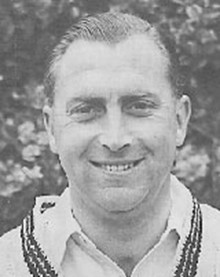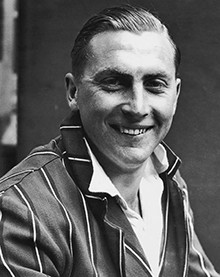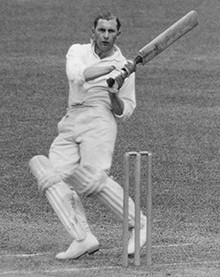Memorial
Harold Gimblett
Biography
Harold Gimblett was born at Bicknoller in the Quantock Hills in west Somerset, where his family had been farmers since the 15th century.[3] He was the youngest of three brothers and was educated at the local school at Williton and then at the fee-paying West Buckland School just over the border in Devon.[4] He played cricket successfully at school and for Watchet Cricket Club. In 1931, he left school; in August of that year, he made the first of his significant innings. In the match between Watchet and Wellington Cricket Club, he came to the wicket with Watchet on 37 for seven, chasing a total of 160. With another teenage batsman, Allan Pearse, Gimblett hit off the runs, making 91 himself.[5] A year later, he was co-opted into the Somerset Stragglers team, a peripatetic amateur team which played matches across south west England, composed of former public school players of varying abilities, some of whom were the amateurs who formed a large contingent of Somerset county players up to the Second World War. In his first match for the Stragglers team, against Wellington School, he made 142 in 75 minutes.[6] Gimblett briefly moved to London to work, but city life was not to his taste and he returned home, resuming cricket for the Watchet club. One of the patrons of Watchet cricket, the town tailor W. G. Penny, who was also prominent in Somerset County Cricket Club, recommended him for a trial with the county, though there appears to have been some reservations over his temperament and his impetuous batting.[7] There is also, in the same source, some suggestion that Gimblett himself was reluctant to test himself against top-class cricketers. Even so, at the start of the 1935 season, Gimblett was invited to go to Taunton for a two-week trial with the county. The trial seems not to have been a success, but it led directly to the sensation that was Gimblett's first-class cricket debu
- source1 - http://en.wikipedia.org/wiki/Harold_Gimblett
- Sources2 - http://www.espncricinfo.com/ci/content/story/533600.html
- image1 - http://en.wikipedia.org/wiki/File:Harold_Gimblett.jpg
- image2 - http://www.espncricinfo.com/ci/content/story/533600.html
- image3 - http://www.espncricinfo.com/ci/content/story/533600.html








